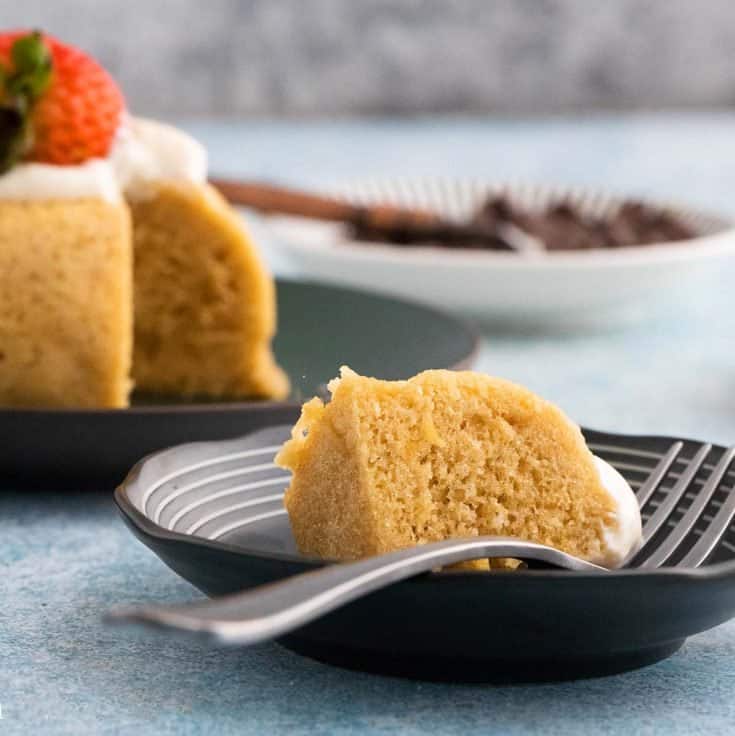These Almond Flour Dessert Recipes are indulgent yet mostly healthy, low carb, and naturally gluten-free. If you are looking for baking recipes using almond flour, then you will find ideas ranging from cakes, cookies, and brownies to even vegan treats that are sure to impress!

What is almond flour?
Almond flour is a fine flour made from grinding blanched almonds. It is delicious, nutritious, with a slightly sweet and nutty flavor, and is a versatile ingredient to make pancakes, waffles, cookies, brownies and cakes.
The popularity of almond flour has surged in recent years as it is commonly used as a gluten-free alternative to wheat flour in baking like almond flour biscuits. It is widely available in all major grocery stores and online. I usually pick up a big bag from Costco and store it in the refrigerator for a long shelf life.
Almond flour vs almond flour
There are two main types of almond flour available in the stores - blanched almond flour and almond meal. Blanched almond flour is made from almonds with their skins removed, resulting in a lighter color and finer texture and can be used seamlessly in baking recipes.
Almond meal, on the other hand, is made from almonds with their skins intact, giving it a coarser texture and a slightly darker color with a more pronounced flavor and is better suited in crumb coating meats or seafood dishes.
In general, almond flour is often preferred for recipes that require a finer, more consistent texture like in healthy pumpkin pancakes, while almond meal is chosen for recipes where a coarser texture is acceptable or even desired.
Recipe FAQs
lt is great substitute for all purpose flour in many baking recipes for it's nutrition and also a naturally gluten-free alternative.
However, it can also add more moisture, due to it's higher fat content and also can cause your baked goods heavy or dense and often needs binding ingredients like eggs, along with leavening agents.
So, if unless your recipe calls for all almond flour, it is a good idea to replace about 50% regular flour with almond flour. I like to adopt this method in my buttermilk waffles recipe to add a nutrition boost.
Additionally, almond flour can burn more easily than wheat flour, so be mindful of baking times and temperatures.
Get creative and try using almond flour in your favorite dessert recipes to create new flavors, textures along with added nutrition.
To make homemade almond flour, simply add blanched almonds into a high speed blender and process until ground into a fine powder. Blanched almonds are almonds that have had their skins removed, resulting in a smoother texture. You can buy them pre-blanched or blanch them at home.
To blanch almonds, start by bringing a pot of water to a vigorous boil. Add the raw almonds into the boiling water and leave them for 2 to 3 minutes. Next, drain and rinse the almonds with cold water to cool them down. Carefully rub the almonds between your fingers to peel off the skins, which should come off easily. Afterward, pat them dry with a clean kitchen towel or paper towel to remove all moisture. Lastly, spread them on a large baking sheet and allow them to air dry for a few hours.
Place them in a food processor or a high powered blender like Vitamix and pulse in short bursts, stopping to scrape down the sides of the container as needed. Continue processing until the almonds become a fine, powdery texture resembling flour. I like to refer to the detailed recipe to make your almond flour by Minimalistbaker.
Transfer the freshly made homemade almond flour to an airtight container, and store it in a cool, dry place or in the refrigerator to keep it fresh.
Storing almond flour properly is essential to maintain its freshness and prevent it from going rancid.
Here's how to store almond flour and information on its shelf life:
Transfer the almond flour to an airtight container or a resealable bag and seal well to prevent air and moisture from getting in.
Label the container with the date you opened the almond flour, so you can keep track of its freshness.
Store it in a cool, dry place, away from direct sunlight, heat, near the stove, oven or humidity.
While it's not required, storing almond flour in the refrigerator or freezer can help extend its shelf life.
The shelf life of almond flour depends on several factors, including how it's stored and the quality of the almond flour.
When stored in a cool, dry place at room temperature, almond flour can typically last fresh for up to 6 months.
If stored in the refrigerator, it can last longer, typically up to 1 year. It's important to note that almond flour is susceptible to absorbing odors and moisture, so it's essential to keep it well-sealed and protected.
If you want to store almond flour for an extended period, you can freeze it. Properly sealed almond flour can last in the freezer for up to 2 years. Freezing can help maintain the flour's quality, but ensure it's in an airtight container to prevent freezer burn.
If you notice any signs of spoilage, such as a rancid smell or an unusual color, it's best to discard it and obtain a fresh batch.
Almond flour cannot be used as a 1:1 substitute for all-purpose flour in most recipes due to several key differences between the two flours.
Almond flour has a slightly coarser texture and consistency than all-purpose flour and doesn't provide the same structure and rise in baked goods.
All-purpose flour contains gluten, a protein that provides elasticity and structure to baked goods. Almond flour is gluten-free, so it can't provide the same structure and rise as all-purpose flour, making it less suitable for recipes like bread.
It also tends to be more absorbent than all-purpose flour. You may need to adjust the moisture content in your recipes to prevent the final product from becoming too dry. This could mean adding more liquid ingredients like eggs, milk, or oil.
It works well in recipes for cakes, cookies, muffins, pancakes, and some types of quick bread. In these cases, you can often replace a portion of the all-purpose flour with almond flour to add a nutty flavor and a moist texture.
If you want to create a gluten-free or lower-carb recipe, it's often best to start with one designed for almond flour instead of trying to replace all-purpose flour in a regular recipe. Still, some trial and error might be needed to get the results you want."
Almond flour is naturally gluten-free, as it is made from ground almonds without any added wheat or grains. Recipes that specifically call for almond flour as the primary flour are often gluten-free. This makes it a popular choice for individuals who need to avoid gluten due to celiac disease or non-celiac gluten sensitivity.
However, it's essential to remember that the overall recipe can still contain gluten if other ingredients used in the recipe, such as baking powder, certain flavorings, or mix-ins, contain gluten. To ensure a recipe is entirely gluten-free, you need to carefully select all the ingredients and confirm that they do not contain gluten or are labeled as gluten-free.
However, you should still exercise caution and read ingredient labels to ensure that all components of the recipe are free from gluten. If you need to maintain a strict gluten-free diet, consider using certified gluten-free ingredients to reduce the risk of cross-contamination.
Want To Save This Recipe?
Almond flour dessert recipes
Whether you're seeking a low-carb option or aiming for a satisfying dessert, almond flour provides the foundation for delicious and wholesome treats. It is a go-to ingredient for creating delectable, gluten-free, and nutritionally-rich desserts that are healthier and decedent.
Did you make any of these recipes? I’d love your feedback! Please let me know by leaving a comment or review below or snap a photo and share on Instagram.
All contents and images are my original work, unless and otherwise mentioned. Please do not use my recipes or images without linking back to www.kitchenathoskins.com. If you wish to republish a recipe, please rewrite in your own words and don’t forget to include a link back to the original recipe.
Some of the links above are affiliate links, which pay me a small commission for my referral at no extra cost to you! I am a participant in the Amazon Services LLC Associates Program, an affiliate advertising program designed to provide a means for us to earn fees by linking to Amazon.com and affiliated sites. Thank you for supporting kitchenathoskins.com.





















Leave a Reply